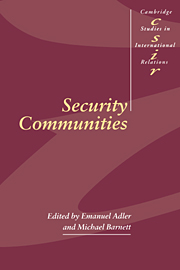Book contents
- Frontmatter
- Contents
- Notes on contributors
- Acknowledgements
- Part I Introduction and theoretical overview
- 1 Security communities in theoretical perspective
- 2 A framework for the study of security communities
- Part II Studies in security communities
- Part III Conclusions
- Index
- CAMBRIDGE STUDIES IN INTERNATIONAL RELATIONS
2 - A framework for the study of security communities
Published online by Cambridge University Press: 30 October 2009
- Frontmatter
- Contents
- Notes on contributors
- Acknowledgements
- Part I Introduction and theoretical overview
- 1 Security communities in theoretical perspective
- 2 A framework for the study of security communities
- Part II Studies in security communities
- Part III Conclusions
- Index
- CAMBRIDGE STUDIES IN INTERNATIONAL RELATIONS
Summary
Security communities never generated much of a research program. Foundering on various theoretical, conceptual, and methodological brakers, the concept of security communities remained largely admired from afar. This chapter aspires to fulfill the initial promise of the security ommunities agenda by offering a reconstructed architecture. The presented framework benefits from the best of Deutsch's original conceptualization and corrects for its shortcomings by borrowing from four decades of substantial insights from sociological and international relations theory and various empirical studies that were informed by the concept of security communities.
This chapter is organized in the following way. The first section begins by offering a conceptual vocabulary for the study of security community. One of the virtues of the study of security communities is also one of its vices: it raises a host of important but potentially intractable concepts such as community, dependable expectations of peaceful change, governance, institutions, and on and on. Therefore, this section begins to provide a conceptual and definitional map. Thesecond section presents a framework for studying the emergence of security communities that is analytically organized around three “tiers.” The first tier consists of recipitating factors that encourage states to orient themselves in each other's direction and coordinate their policies. The second tier consists of the “structural” elements of power and ideas, and the “process” elements of transactions, international organizations, and social learning. The dynamic, positive, and reciprocal relationship between these variables leads to the third tier: the development of trust and collective identity formation.
- Type
- Chapter
- Information
- Security Communities , pp. 29 - 66Publisher: Cambridge University PressPrint publication year: 1998
- 112
- Cited by



